Lecture 15 - Biogeography and Biodiversity
1/24
Earn XP
Description and Tags
included on exam 3
Name | Mastery | Learn | Test | Matching | Spaced |
|---|
No study sessions yet.
25 Terms
biogeography
the study of the distribution of living things
provides evidence for evolution
biogeographic evidence for evolution
1) similar climates occur across the globe, but the organisms inhabiting different regions are often unrelated
2) barriers to dispersal are related to differences in the assemblage of species (larger barriers are associated with greater differences between species)
3) remote islands have mostly species capable of long-distance dispersal; but when introduced by humans, other species flourish
island species are usually most closely related to species on the nearest mainland
ways geographic ranges change
vicariance
dispersal
extinction (of populations, not of an entire species)
vicariance
the splitting of geographic ranges by a physical barrier
one way geographic ranges can change
in picture: 5 different flower species along the Mississippi river
Mississippi river is 70 million years old
the MRCA of the five species likely diverged into two lineages ~70-50 million years ago (red+orange and green+blue+purple)
river between blue+purple is likely older than the river between green+blue (river is a barrier
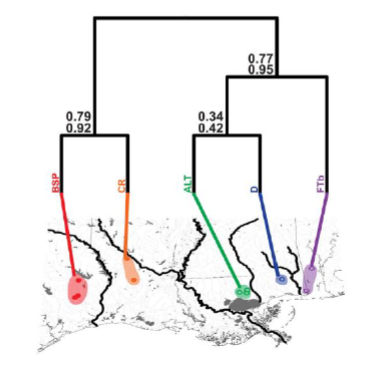
dispersal
movement to areas
one of the ways geographic ranges change
e.g. the movement of starlings during recent human history
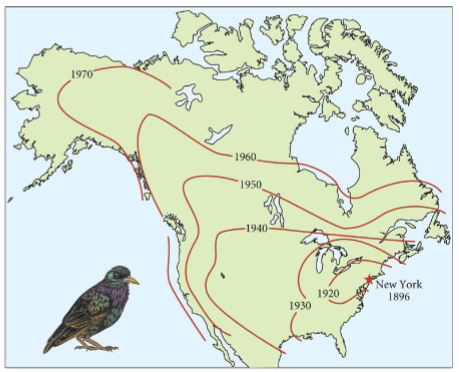
extinction of populations
the removal of parts of a geographic range
one way geographic ranges change
a frequent cause of discontinuous distributions (e.g. after glaciation) (see the circles in the picture; the entire range used to be taken up by Pinus radiata, but many populations went locally extinct after glaciation, leaving just the circled distribution)
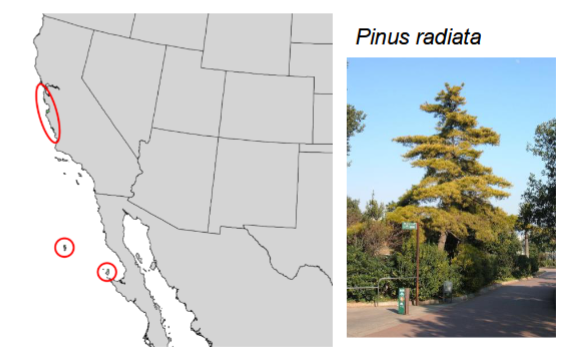
typical exceptions to Wallace’s line
birds and bats
factors (historical and current) that maintain Wallace’s line
plate tectonics (historically) and deep-water trenches (historically and currently)
Why are islands biased toward having certain types of species?
evolutionary history
can help us determine how closely related island species are toward the nearest mainland species
sky islands
islands separated by desert instead of water
often at a much higher elevation than the deserts
some organisms can live in the pine/fir forests, but not in the desert
one possible way for organisms to get from one sky island to another is via dispersal (e.g. birds flying from island to island)
estimations can be made about what the biome used to look like; sky islands used to connect with more pine forest
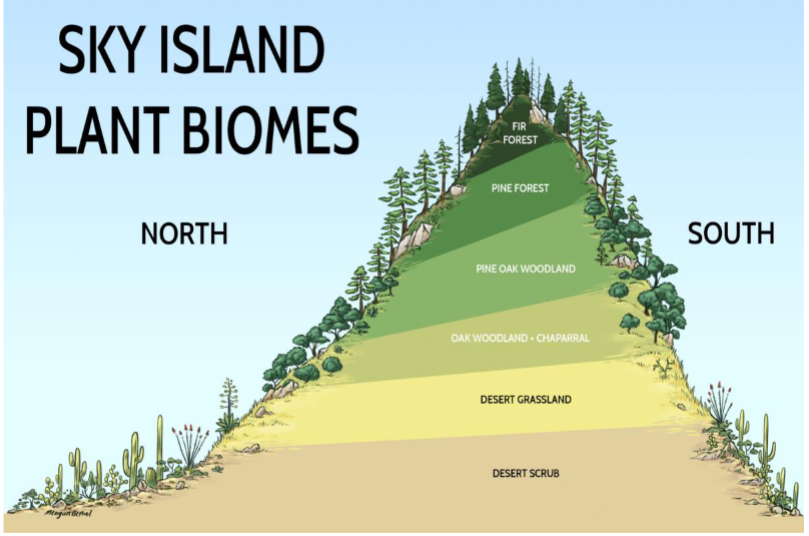
possible hypotheses that can explain why animals are found in sky island tops, but cannot survive in the deserts below
the deserts act as a barrier
all the organisms started on one island, then dispersed to the other sky islands
one species originally occupied the entire area, then the desert areas eridicated and went extinct
net diversification rate
represented by r
net rate of change in the number of species over time
r = speciation rate (lambda) - extinction rate (mu)
varies greatly across taxa, even across those of similar age

speciation rate
rate at which new species are formed
represented by lambda
one of the things affecting net diversification rate

extinction rate
rate at which species are lost
represented by mu
one of the things affecting net diversification rate

Why do speciation rates vary so greatly across taxa?
time: older lineages have simply had more time to speciate
difference in speciation: some species may have a trait that promotes speciation
difference in extinction: some species may have a trait that prevents extinction
example: does weaponry influence speciation/diversification?
any lineage could speciate, go extinct, or evolve (weaponless could grow weapons, or weaponed could lose weapons)
analysis: compare branch lengths, ordered longest to shortest (longer branch = more time)
the longer branches tend to not have weapons → speciation takes longer to occur
the shorter branches tend to have weapons → speciation occurs more quickly

patterns of diversity over time
2 major patterns in the fossil records: mass extinctions are common (5 in the fossil record) (know 2 of them); but diversity rebounds after mass extinctions
fossil record patterns suggest competition: direct competition or incumbent replacement
direct competition (competitive displacement)
one taxon outcompetes another
as one clade decreases in number of species, the other clade increases
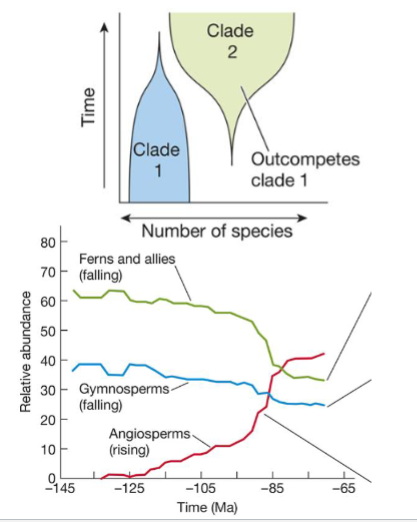
incumbent replacement
one taxon takes advantage of the other ‘s absence
e.g. mammals diversified when dinosaurs died
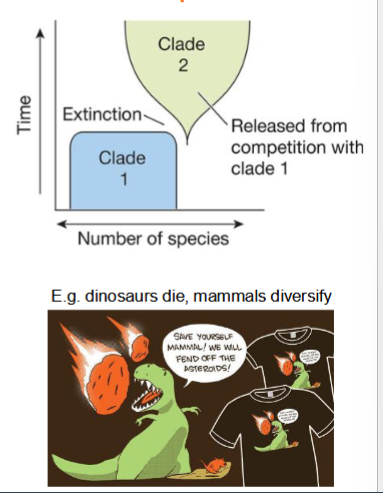
the latitudinal diversity gradient
diversity is highest in:
the tropics (vs the temperate zone)
at middle elevations (in mountains)
on land (vs in the water)
2 hypotheses to explain this gradient
e.g. frogs in the family Hylidae: species diversity is higher in the tropics, and hylids originated in the tropics
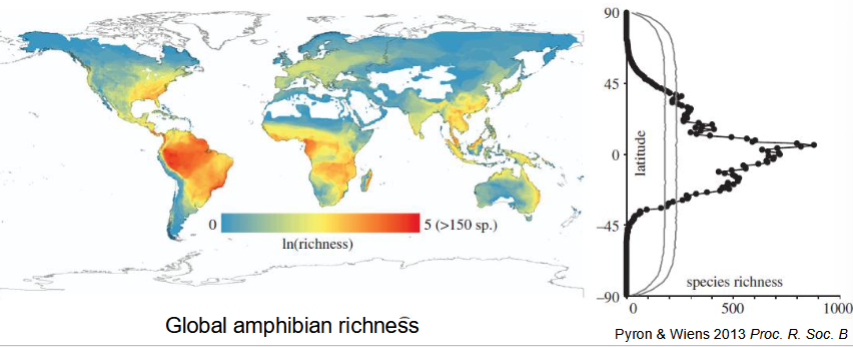
2 hypotheses explaining the latitudinal diversity gradient
H1: positive feedback hypotheses
H2: time for speciation hypotheses
positive feedback hypothesis
one of the two evolutionary hypotheses to explain diversity differences/the latitudinal diversity gradient
higher diversity leads to higher diversification rates
time for speciation hypothesis
one of the two evolutionary hypotheses to explain diversity differences/the latitudinal diversity gradient
habitats with high levels of diversity are older, so there has been more time for speciation to take place
rates of trait evolution
traits evolve at different rates
e.g. horseshoe crabs: the species is still evolving, but the rate of morphological evolution is very slow, which is why fossils and current horseshoe crabs look very similar
characters with strong functional relationships evolve more slowly
characters with strong biomechanical functions evolve more slowly (e.g. traits associated with jumping in frogs, or flight in birds)
mosaic evolution
mosaic evolution
characters often evolve independently of one another
leads to species composed of some fast-evolving characters and some slow-evolving characters
e.g. traits for wing color might evolve quickly, but traits for wings themselves evolve slowly
e.g. overall frog body form is conserved with slow evolution, but reproductive biology is highly variable with fast evolution